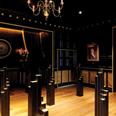Awakening the senses
A three-dimensional marketing approach that engages all the senses will not only boost food and drink sales but can translate into various sectors – and could add $100m to a brand’s value.

Print Power
“Thinking about your brands in terms of pictures, not just words, is really powerful, but why wouldn’t you use all the senses? Three-dimensional marketing is about a more holistic view of what your brand stands for and is about.”
That is the view of Diageo global brand director for single malt whiskies Nik Keane. The company is purposefully moving towards creating sensory ‘worlds’ for its brands, rather than simply using words to describe them in communications.
The economic effect of sensory marketing has been measured by Unilever’s Dove soap brand. Research consultancy Millward Brown estimates that the smell of the product contributes $63m (£39m) of its annual US revenues, while touch accounts for $34m and sight $14m. The smell has been found to make users feel ‘relaxed, valued and calm’.
Millward Brown chief global analyst Nigel Hollis says that maintaining a brand’s formulation, and therefore how it engages four out of five senses, is critical to its success. “Imagine you were considering changing the Dove formulation to a cheaper recipe that would save $5m a year but would negatively affect the user’s experience,” he says in his new book The Meaningful Brand: How Strong Brands Make More Money. Having seen brands change the way they use the senses result in a negative effect, he asks: “Might the suggestion that the decision would affect over $100m in revenues based on the sensory experience give you pause?”
Sensory marketing is not only useful in the beauty and food and drink industries, it is also becoming important for products that rely less on the senses, such as travel and insurance (see boxout, below).
“We spend a lot of time using words – that’s our day-to-day way of communicating as marketers,” Keane says. “What we’ve seen is a growth in brand worlds, so moving into visualising brands, and this is the next step on that journey – from two-dimensional to three-dimensional marketing.”

The Velvet Chamber
Diageo’s Dublin tourist attraction the Guinness Storehouse has attracted more than 12 million visitors since opening in 2000. Visitors can learn how to pour the perfect pint of Guinness and cook with the beer. In August, it unveiled a new multi-sensory brand experience, The Tasting Rooms, a series of chambers at the heart of the brewery (see Q&A).
It was designed by food architects Bompas & Parr, who worked with flavour scientists to define the environmental factors that enhance taste perception. It includes ‘flavour fountains’, which emit vapours of beer, malt, roasted barley and hops – the key tastes in Guinness. These were determined in consultation with Guinness master brewer Fergal Murray.
“It’s to get your sense of smell ready, so that you’re tasting with your sense of smell,” says Catherine Keegan, customer experience manager at the Guinness Storehouse. Sensory marketing enables brands to engage with consumers on a much deeper level. “It’s about making our marketing richer, being more multi-dimensional,” says Keane. “I believe that the best work has a disproportionate economic impact. It makes good business sense therefore to shoot for extraordinary things. Understanding areas like this makes the things we do more beautiful and more effective.”
Bompas & Parr also recently worked on the launch of Heinz Flavoured Beanz. Using the premise that taste buds are linked to our other senses, the pair designed a handcrafted bowl and musical spoon to accompany five new flavours, including curry, chilli and barbecue.
The textures and colours of the bowls are designed to further signify flavour associations. The Heinz Beanz Cheddar Cheese Flavour Experience, for example, includes a circular bowl made of cast yellow wax, based on the form, texture and colour of a traditional round of cheese. MP3 players have been fitted inside the spoons that play specially composed soundtracks to enhance the key flavours.
Inaudible until placed in the mouth, these themes can be heard when biting on the spoon. The Heinz Beanz Curry Flavour Experience, for example, is paired with Punjabi Bhangra music. “As the nation’s tastes evolve and become more sophisticated, Heinz Flavoured Beanz have been introduced to offer a new taste experience while remaining true to the flavours of the beans we know and love,” says Katherine Broadley, senior brand manager at Heinz Beanz. However, they are not cheap, at £57 for the tins plus bowls and spoons, available only at Fortnum & Mason on a trial basis.
Using sensory marketing might be dismissed as a gimmick or publicity stunt, but as the techniques become used more widely, research is helping to prove its worth as a marketing channel. Tests show the environment in which whisky is consumed changes people’s perception and enjoyment of its flavour by up to 20 per cent, for example.
An experiment by Oxford University and sensory architects Condiment Junkie discovered that people in a ‘fruity’ room with a red colour scheme and fruits found Scotch whisky The Singleton up to 13 per cent sweeter, while those in a wood-panelled room accompanied by the sound of crackling logs enjoyed the whisky up to 15 per cent more than in the other two rooms.
Professor Charles Spence, head of crossmodal research at Oxford University’s Department of Experimental Psychology, says the results are significant. “It has implications for anyone looking to enhance their whisky experience in a bar, restaurant, or even from the comfort of their own homes. Notable chefs have embraced the potential when working with all the senses to deliver powerful tasting experiences.”
Enhancing the experience of a product in this way could be vital in gaining an edge over competitors. Keane at Diageo, which produces The Singleton, says: “Twenty per cent is more than a small edge and can make the difference between whether your product is more extraordinary than someone else’s.
“This can have implications for the texture and sound of packaging and for how products get served – the colour of the glasses, the weight of the plates. It affects how products are consumed and how we encourage people to drink them.”
The findings from the study were published this month in peer-reviewed academic journal Flavour. “We were delighted to get that scientific paper published. Up until then it sort of sounds good, but really, particularly if you’re the marketer presenting this to the board or sales director, work like this does show the potential in numbers,” says Keane.
Research companies such as Marketing Sciences and Insight on Foods have been conducting sensory research for a long time to help brands understand how consumers experience their products and how they make people feel (see boxout below).
Insight on Foods recently launched a database providing insights into healthier food that still has the emotive rewards people want. Mapping the taste, textures and ‘mouth-feels’ that drive key emotions, this helps the food and drink industries with salt, sugar and fat reduction, which are part of the Government’s voluntary Responsibility Deal that supermarkets, food manufacturers and restaurant chains have signed up to.
The company claims to have identified algorithms to find the key taste, texture, mood and emotional connections that drive certain characteristics such as healthy, moreish, light yet indulgent, stimulating or relaxing.
“The Index is most used to find those elements, both taste and emotion, that are present in the successful products in their category, but also to look at more esoteric concepts such as healthy taste notes or what mouth characteristics contribute to ‘moreishness’,” explains Thornton Mustard, founder of Insight on Foods.
Marketing Sciences has worked with brands such as Danone and Twinings to help them launch line extensions and conduct sensory profiling.
Danone used different forms of testing when it wanted to enter the UK desserts market with a low-fat product that did not compromise on taste. Using a combination of consumer and sensory testing, people said which products they liked and sensory profiling gave detailed information on how products in the market differed.
Advanced analytics combined the two to understand key drivers of taste and to help optimise Danone’s proposed products. Within six months, the product had achieved 5 per cent penetration in desserts and driven category growth of 14 per cent with the Shape Delights range accounting for 40 per cent of that.
Although sensory techniques are often used in relation to the food and drink sector, employing these methods can also have a significant effect in other sectors and channels.
Print Power, a pan-European organisation that promotes print media, is currently running a sensory direct marketing campaign. It claims that as brands are using digital means to reach customers, they might be missing out on sensory contact with their consumers and therefore building long-term loyalty. Its direct mail campaign consists of a blackboard card with a hidden message that people could use to leave a print of their chalk-covered hand on a reply card that would be printed on the cover of a notebook. Print media has the ability to offer different sensory experiences, namely vision, feel, taste, sound and smell, which according to Millward Brown’s Brand Sense research can increase brand impact, explains the organisation.
According to the research, commissioned by brand consultant and author Martin Lindstrom, when brands appeal to more than three senses, and therefore different parts of the brain, sensory print can increase brand impact and engagement by more than 70 per cent.
Based on the idea that by engaging multiple senses, the emotional connection with consumers will be stronger and last longer, creating a sensory print strategy could mean advertisements are more effective.
“Print’s special sensory qualities, particularly touch, just cannot be emulated online. Linked with a well-targeted and imaginative mail campaign, it will deliver impressive results and importantly, high return on investment,” says Martyn Eustace, country manager for Print Power UK.
Other sectors, such as the beauty industry, consider smell, touch, look and feel when marketing their products, yet marketers tend to focus on communicating product benefits, says Millward Brown’s Hollis.
“Although as marketers we focus much of our attention on communications and positioning, we cannot afford to dissociate them from the experience of the product itself; much of a brand’s value rests in consumers’ memories of their experience with it,” he says.
Keane at Diageo cites the luxury sector and retailers as good examples of those reaping the benefits of sensory marketing. An age-old example would be supermarkets pumping the smell of freshly baked bread to the front of the store.
“Retailers, particularly at the luxury end of the market, ‘own’ physical spaces and they are in effect operating in a 3D world. Most FMCG brands are being sold within someone else’s environment. There’s a lot we can learn from retailers and particularly luxury retailers that have been using this to different degrees for some time.
“Brands on the shelves don’t own that space, so we tend not to think in that three-dimensional way. Now you see brands owning their own retail space or brand home and once you start doing that, you start thinking in some of these ways. What does my brand smell like, what does it taste like, even if I’m not in food and beverages.”

Sensory kitchen
Keane says that sensory marketing techniques can even be used online. “It would be a mistake to assume that 3D marketing is only about physical spaces. It’s about how we bring things to life and that includes your mobile phone and laptop.”
Professor Spence’s research with Condiment Junkie found that one sense can affect another, such as a soundtrack influencing whether you think a running tap is hot or cold, he says.
“If you then apply that to a vodka that is clean and crisp, when I’m building a website, I can think about what that website would sound like and that will in turn affect how people feel about the pictures on the website.
“I don’t know what the temperature of your room is, but with the right imagery and the right sound, things could feel colder. It’s a degree, it’s not going to suddenly feel tropical or arctic, but when you’re looking to do as good a job as you can to bring your consumer an experience, you can create a world that is more sensorial than you might expect, even through a computer screen when all you’ve got is visual and sound.”
Sensory testing
Sensory testing allows companies to analyse consumers’ experience of brands. Panellists are selected on their high ’sensory acuity’ on all five senses and are trained extensively to individually score each product on a range of attributes. Statistical consultants then analyse the results. Sensory techniques take the diagnosis of products to a level beyond the ability of the general consumer to create a sensory profile for each product.
“It’s the quintessential test for finding out in detail about a product with respect to the sensory attributes,” says Dr Angie Reyner, associate director, sensory at Marketing Sciences. “Information is power. The more information you get about your brand, the more you can tweak it.”
The five senses are taste (flavour), smell (aroma), sight (appearance, colour, shape, size), touch (texture, ‘mouth feel’) and hearing (noise). The sensory profile can also help brands with new product development and quality control when a product is produced by different factories or a company is changing recipes.
Panellists score products against the above attributes using language that they define themselves. It can be particularly interesting for marketers to hear the vocabulary used to describe their products, says Dr Reyner.
“Panellists see a whole new area to that product that brands may have missed; they’re picking up attributes that haven’t come to light before,” she says. “The panel might come back and say they taste metallic. You might not think it’s metallic but there are people who are picking up those notes.
“In terms of marketing, it might throw up interesting angles.” Brands can also use the results in their marketing, by using claims such as ‘50 per cent of panellists say X product tastes more creamy than our competitors’.
Q&A
Catherine Keegan
Customer experience manager
Guinness Storehouse (Guinness-themed tourist attraction in Dublin)
Marketing Week (MW): Why did you create The Tasting Rooms?
Catherine Keegan (CK): Guinness is a distinctive beer in terms of look and flavour. We wanted to celebrate that and dispel myths around Guinness being a challenging drink to get to know.
We know that it’s a beer that takes hold of all the senses, that is beautiful to look at, that when you hold the glass it’s cold. It’s a beer you’ve got to taste in a certain way.
We have a real opportunity to tell those that love Guinness something they didn’t know and get first-time drinkers to give it a chance. Even though they may not like it, they’ll know why it tastes the way it does, why it’s a beer that’s made with passion and why it’s different from other beers.
MW: How do visitors react to this sensory brand experience?
CK: The concept grabs hold of people’s senses and gives them an opportunity to appreciate all the distinctive things about Guinness. We will have 1.4 million visitors every year, so needed something accessible to all. It’s not like an in-depth wine tasting – there’s no time for that – you’ve got to get the message over fairly quickly.
People go from a dark corridor that narrows into a white space that’s bright with swirling vapours presenting the key tastes found in a [pint of] Guinness. Then you go into another darkened space that’s velvet-lined, old world, reinforcing the taste and textural aspects of the liquid. Bompas & Parr, who designed the space, worked with music specialist Dom James, who composed a soundtrack for the whole thing.
MW: How are you measuring its success?
CK: By measuring customers’ reactions and feedback. In the future, we want to measure how brand homes such as the Storehouse influence consumption and visitor’s behaviour after they leave. That’s groundbreaking for us. We want to be able to show the effect that something like the home of Guinness has as an immersion tool for our brand.
The brands using sense
Kuoni
Kuoni launched a creative and interactive campaign last week to awaken the senses of unsuspecting Bluewater shopping centre visitors. It commissioned an antique-style map of the world with 10 destination buttons, which when pushed released a puff of sensory aromas that captured the essence of the destination. Kuoni hopes the ‘Scents of Adventure’ map will ignite thoughts of holidays and travel ambitions to exotic, far flung lands and is keen to find out if the sense of smell could be an inventive new way of defining the travel experience.
Mercedes-Benz
Mercedes-Benz launched a ‘Sound with Power’ campaign this month with ads that feature a man sitting in a Mercedes-Benz E 63 AMG, wearing a suit fitted with LEDs. The LEDs light up differently depending on which sound is played, illustrating his emotional response. This builds up to the character being ‘played’ the sound of the vehicle’s engine, and the outfit reflecting his pleasure. The ad features Tinie Tempah’s track Pass Out. The brand also launched an online tool that encourages audiences to mix the sounds played on the TV ad with the track.
Standard Life
Standard Life investigated the emotions people feel when they think about saving for their future. The research, Saving in Mind, used neuroscience to test how communication can help to change the way people feel. It claims that this is the first time these techniques have been used by the financial sector. The company aims to understand customers’ emotions, which in turn affects what decisions they make. Communication with a positive and helpful tone is motivating when talking about long-term savings, say the findings, stimulating dopamine that can in turn encourage the ‘love hormone’ oxytocin.









